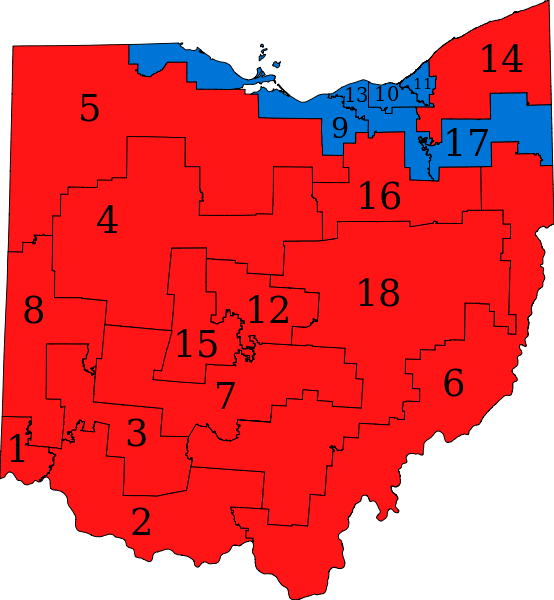Sinclair: Gerrymandering has to end

Ohio’s congressional districts, 2011-2013.
January 21, 2018
It is an assumption that, in America, elections are fair and representative of the wants and needs of the population. At least, they should be.
One of the biggest threats to fair and balanced elections is gerrymandering. Gerrymandering is when a political party draws district boundaries in a way that unfairly favors them.
And this isn’t a new phenomenon.
Elbridge Gerry was the first governor to redraw district lines in 1812. He contorted the state lines in a way that would give Republicans in Massachusetts at the time an advantage in state senate elections.
Others have continued to follow his example.
Now to be clear, both parties are guilty of gerrymandering. I’m not here to attack either party, but there have recently been enormous and unfair uses of gerrymandering in order for Republicans to win seats in Congress, especially in the 2016 elections.
In 2016, Republicans won “as many as 22 additional U.S. House seats over what would have been expected” due to gerrymandering. This helped give them an unfair majority in the House.
A similar phenomenon happened in the 2012 elections. Despite House Democrats earning more than 1.17 million more votes than their Republican counterparts, they lost the majority in the House of Representatives. How do you win the popular vote but lose your seats in the House?
Gerrymandering, that’s how. The two primary methods of gerrymandering are packing and cracking.
Packing is when you place voters of the opposing party in a few select districts so they are limited in the number of seats they could win. It is similar to a scheduled loss in basketball. A team knows they aren’t going to win every game, so they plan on losing certain games so they can rest key players and avoid injuries while getting to the playoffs in good shape.
Cracking is a little different. Cracking is when you spread the opponents voter base thin across a bunch of different boundaries so their votes carry less power.
These two strategies have led to some incredibly obvious gerrymandering. Many of the strange shapes gerrymandering creates get their district fun nicknames, like “The Praying Mantis” or “Goofy Kicking Donald Duck.” It is frankly, unbelievable.
So how do we go about fixing this structural problem?
I believe the best way to fix gerrymandering is to redraw district lines using an algorithm that is fair and unbiased. This would remove the problem of politicians drawing district lines and it would allow for the proper representation in each district.
But I don’t see this happening anytime soon. That is a lot of power for politicians to give up, especially if the Republicans are scared of being unable to win a majority of seats in the House without gerrymandering.
So that remains a pipe dream at the moment. But what is not a pipe dream right now is the fact that there is currently a case at the Supreme Court which could find gerrymandering unconstitutional.
Gill v. Whitford challenges the redrawing of Wisconsin’s congressional districts by Republicans that would assure them a majority in almost any voting scenario in subsequent years.
If the Supreme Court finds partisan redistricting unconstitutional, we might be able to restore balance to these elections that have been manipulated by gerrymandering.
I have faith the Supreme Court will see the obvious dangers of gerrymandering and find it unconstitutional. No matter which party is drawing the lines, gerrymandering dilutes the power of a single vote and can incorrectly represent the will of the people.
Gerrymandering has to end, clear and simple.






